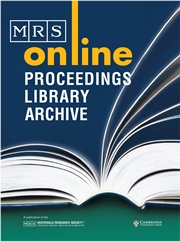Article contents
Stress Induced Void Nucleation in Narrow Aluminum Alloy Lines
Published online by Cambridge University Press: 15 February 2011
Abstract
The stress induced failure of passivated aluminum based metallizations is the combined result of the stress induced void nucleation and growth of voids. The present work investigates the dependence of the void nucleation on aging temperature and cooling rate. Narrow Al, Al(0.2%Cu) and Al(2%Si) lines of different widths were fabricated by lift-off and passivated with various thicknesses of Si3N4. After a 400°C anneal, the specimens were cooled directly to the selected aging temperature and aged for up to 1100 hours. Void nucleation was found to occur predominantly during the initial cool-down. The rate of nucleation varied in quite different ways with the combination of aging temperature and cooling rate for the different alloys, which is consistent with a grain boundary sliding controlled nucleation mechanism.
- Type
- Research Article
- Information
- Copyright
- Copyright © Materials Research Society 1991
References
REFERENCES
- 4
- Cited by


